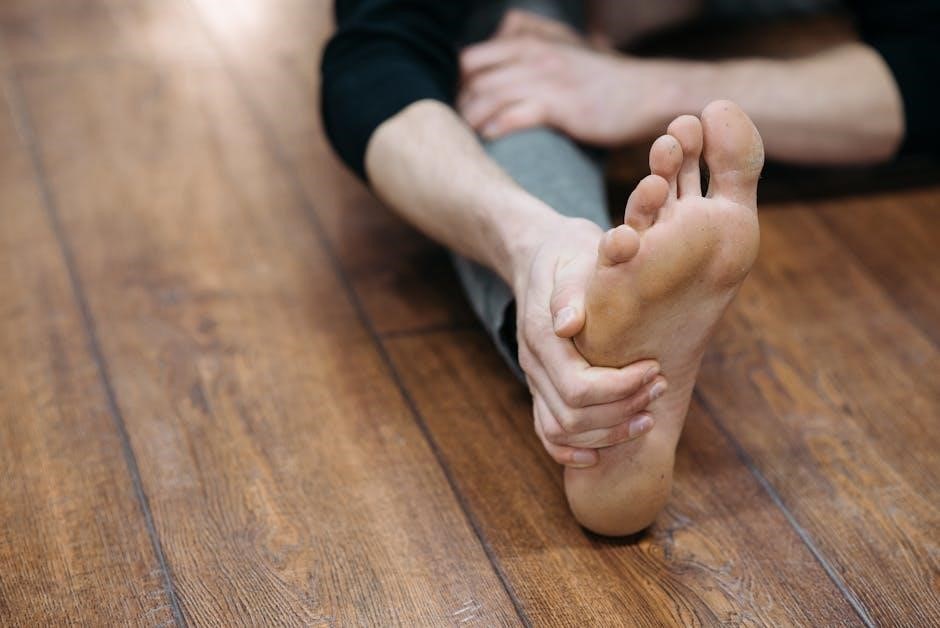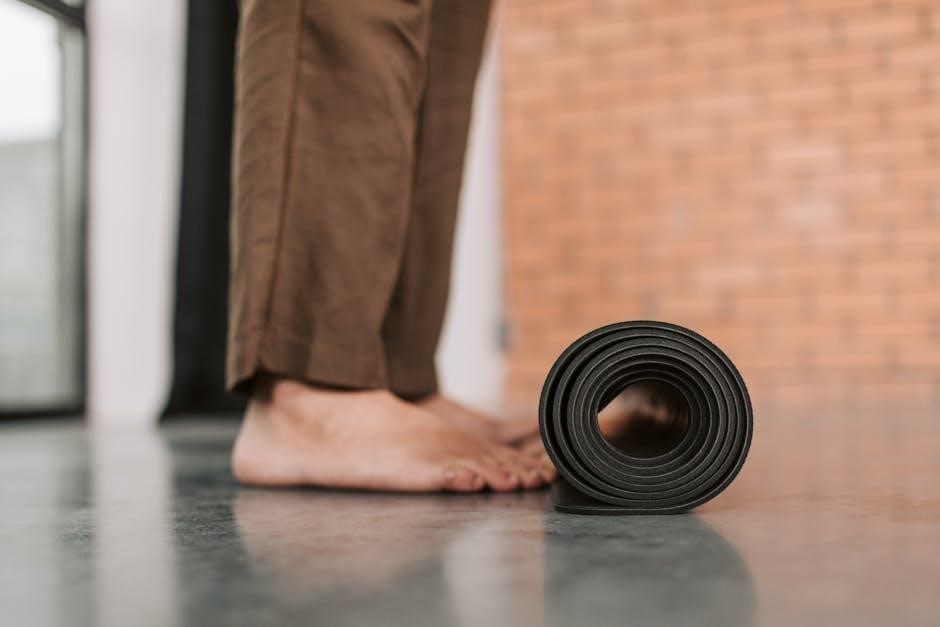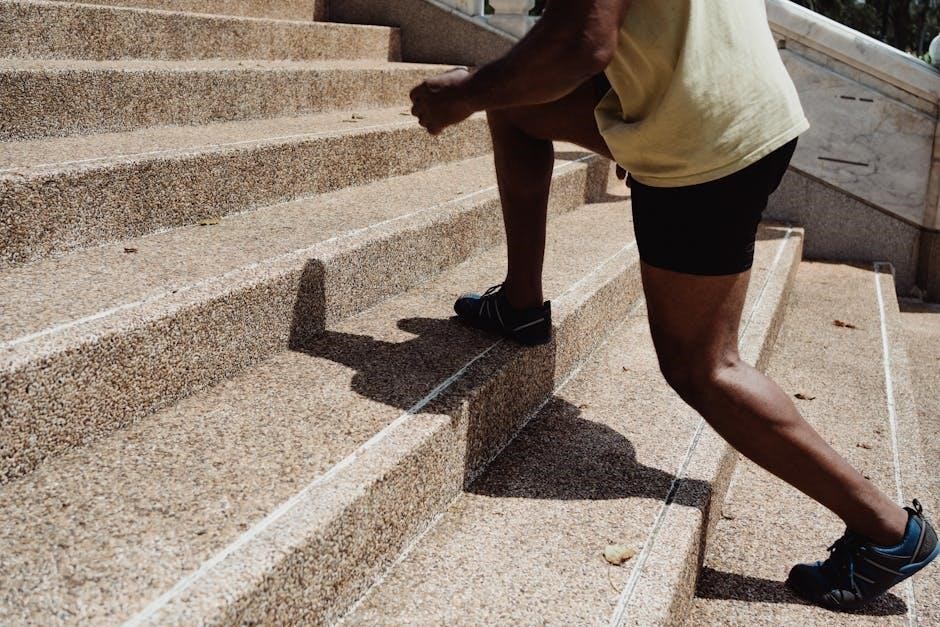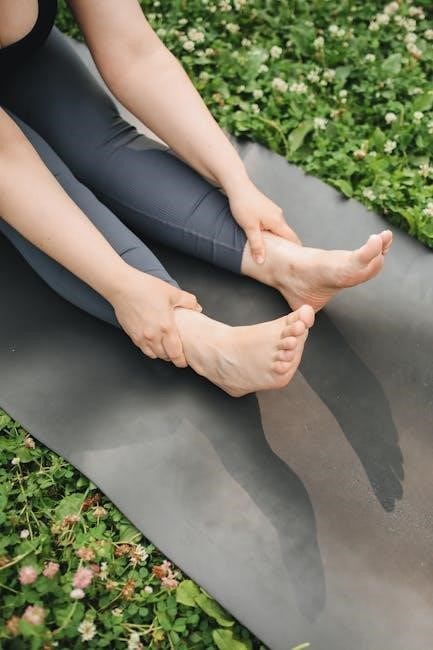Overview of Foot Extensor Tendonitis
Foot extensor tendonitis is an inflammation of the tendons on the top of the foot, causing pain and stiffness, especially during movement․ It often affects active individuals and can significantly impact daily activities if left untreated․ Common causes include overuse, repetitive stress, or improper footwear, leading to pain and stiffness․ Early diagnosis is crucial to prevent chronic pain and mobility issues, ensuring effective treatment and recovery․ Exercises play a vital role in managing the condition, promoting healing, and preventing future injuries․
1․1 Definition and Explanation
Foot extensor tendonitis is an inflammation of the tendons on the top of the foot, causing pain and stiffness, especially during movement․ These tendons, responsible for toe movement and foot stabilization, become irritated due to overuse, repetitive stress, or improper footwear․ The condition often affects active individuals, leading to discomfort during activities like walking or running․ If left untreated, it can progress to chronic pain and limited mobility․ Early diagnosis and appropriate management are essential to restore normal foot function and prevent long-term complications․ The inflammation disrupts daily activities, making prompt treatment crucial for recovery and maintaining foot health․
1․2 Common Symptoms and Signs
Common symptoms of foot extensor tendonitis include pain and swelling along the top of the foot, particularly during activities like walking or running․ Tenderness, stiffness, and difficulty moving the toes are frequent complaints․ Pain may worsen with weight-bearing activities or when flexing the feet․ Swelling and redness over the affected tendons can also occur․ In severe cases, mobility may be limited, making everyday tasks challenging․ These symptoms often develop gradually, starting with mild discomfort and progressing to more pronounced pain if left untreated․ Early recognition of these signs is crucial for effective management and recovery․

1․3 Importance of Early Diagnosis
Early diagnosis of foot extensor tendonitis is crucial to prevent progression to chronic pain and mobility issues․ Prompt identification allows for timely intervention, reducing inflammation and promoting faster recovery․ Untreated cases can lead to prolonged discomfort, limited activity, and increased risk of re-injury․ Early diagnosis enables individuals to begin appropriate exercises and modifications, avoiding exacerbation․ It also minimizes the need for more invasive treatments, ensuring a smoother and more effective recovery process․ Addressing symptoms early enhances long-term foot health and functionality, allowing individuals to resume normal activities without prolonged setbacks․

Causes and Risk Factors
Foot extensor tendonitis is often caused by overuse, repetitive stress, poor footwear, and biomechanical issues like flat feet, leading to inflammation and pain in the foot’s extensor tendons․
2․1 Overuse and Repetitive Stress
Overuse and repetitive stress are primary causes of foot extensor tendonitis, often resulting from activities like running, dancing, or excessive walking․ These actions strain the extensor tendons, leading to inflammation and pain․ Individuals engaging in sports or jobs requiring frequent foot movement are at higher risk․ Prolonged stress on the tendons can cause micro-tears, exacerbating the condition․ Rest and activity modification are crucial to prevent further damage․ Addressing overuse early can help avoid chronic inflammation and promote recovery․ Consistent exercise routines, including stretching and strengthening, are essential for long-term tendon health and injury prevention․
2․2 Poor Biomechanics and Footwear
Poor biomechanics, such as flat feet or abnormal gait patterns, can strain the extensor tendons, leading to tendonitis․ Improper footwear, including tight or unsupportive shoes, exacerbates the issue by altering foot mechanics and increasing tendon stress․ High heels or shoes lacking arch support can further aggravate the condition․ Addressing these factors is crucial for recovery and prevention․ Orthotics or custom insoles can help correct alignment, while proper footwear provides necessary support and cushioning․ Ensuring footwear fits well and accommodates natural foot movement is essential to reduce strain on the extensor tendons and promote healing․
2․3 Contribution of Flat Feet and Gait Issues
Flat feet and gait issues significantly contribute to foot extensor tendonitis by altering normal foot mechanics; Flat feet can lead to overpronation, increasing strain on the extensor tendons․ Abnormal gait patterns, such as limping or uneven weight distribution, further exacerbate tendon stress․ These biomechanical inefficiencies can cause repetitive stress and inflammation, leading to pain and stiffness․ Addressing flat feet and gait issues is crucial for recovery and prevention, often requiring orthotics or gait training to restore proper foot alignment and movement patterns․ This helps reduce tendon strain and promotes long-term foot health․
The Role of Rest and Activity Modification
Rest is crucial for healing, while activity modification prevents further strain․ Avoiding high-impact activities and gradually returning to exercise helps manage symptoms and supports recovery effectively․
3․1 The Importance of Rest in Recovery

Rest is essential for healing foot extensor tendonitis, as it allows the tendons to recover without further irritation․ Avoiding activities that stress the foot prevents chronic inflammation and supports the body’s natural repair processes․ While complete immobilization isn’t necessary, minimizing weight-bearing activities and avoiding aggravating movements is crucial․ Rest creates an environment for tendon repair, reducing the risk of long-term damage․ Combining rest with gentle, low-impact exercises promotes recovery without overloading the tendons․ This balanced approach ensures proper healing and prevents the condition from worsening, making rest a cornerstone of effective recovery․
3․2 Modifying Activities to Avoid Exacerbation
Modifying activities is critical to prevent worsening foot extensor tendonitis․ Reducing high-impact movements and avoiding repetitive stress allows the tendons to heal․ Switching to low-impact exercises, such as swimming or cycling, can maintain fitness without aggravating the injury․ Avoiding tight footwear and ensuring proper lacing can also reduce strain․ Even small adjustments, like taking regular breaks during activities, can make a significant difference․ By avoiding movements that cause pain or discomfort, individuals can prevent further inflammation and promote a faster recovery․ Activity modification ensures the tendons are not overburdened, supporting the healing process and reducing the risk of chronic issues․
3․3 Low-Impact Exercises as an Alternative
Low-impact exercises are an excellent alternative for managing foot extensor tendonitis, allowing individuals to stay active without exacerbating the injury․ Activities like swimming, cycling, or using an elliptical machine are ideal, as they minimize stress on the foot tendons․ These exercises promote blood flow and muscle strength without overloading the affected area․ Gentle movements, such as water aerobics or yoga, can also be beneficial․ Consistency is key, but exercises should be performed with care to avoid aggravating the tendons․ Low-impact alternatives support recovery while maintaining overall fitness and mobility, ensuring the tendons heal without further strain․

Exercise Program for Foot Extensor Tendonitis
A structured program including stretching, strengthening, and phase-based exercises over 8 weeks helps manage symptoms and promote tendon healing through targeted movements like calf raises and towel curls․
4․1 Stretching Exercises
Stretching exercises are essential for managing foot extensor tendonitis, improving flexibility, and reducing stiffness․ Toe raises and spreads are simple yet effective, strengthening extensor tendons and enhancing mobility․ Ankle pumps and circles promote blood flow and reduce tension, while calf stretches target tight muscles contributing to tendon strain․ These exercises should be performed gently, avoiding pain, and held for 20-30 seconds․ Regular stretching improves tendon alignment, reduces inflammation, and prevents reinjury․ Consistency is key to restoring normal foot function and alleviating discomfort․ Incorporating these stretches into a daily routine supports long-term recovery and overall foot health․
4․2 Strengthening Exercises
Strengthening exercises are vital for foot extensor tendonitis recovery, focusing on building tendon and muscle resilience․ Towel curls and marble pickup exercises target the small muscles of the foot, improving grip and stability․ Resistance band exercises provide controlled resistance, enhancing tendon strength without overloading․ Progressive loading techniques gradually increase intensity, ensuring tendons adapt without strain․ These exercises promote proper alignment, reduce injury risk, and restore functional strength․ Consistent practice strengthens the extensor tendons, alleviates pain, and supports long-term recovery․ Incorporating these exercises into a structured routine is essential for achieving optimal tendon health and preventing future flare-ups․

4․3 Phase-Based Exercise Plan (8 Weeks)
A structured 8-week exercise plan for foot extensor tendonitis focuses on gradual progression to ensure proper healing and strength restoration․ Phase 1 (weeks 1-2) emphasizes rest and gentle exercises like toe raises and ankle pumps to reduce inflammation․ Phase 2 (weeks 3-4) introduces low-impact activities such as calf stretches and resistance band exercises to improve flexibility and strength․ Phase 3 (weeks 5-8) incorporates progressive loading and functional movements to prepare for return to normal activities․ Each phase includes specific exercises with sets, repetitions, and intensity adjustments to avoid overexertion․ This phased approach ensures a safe and effective recovery process․

Stretching Exercises for Recovery
Stretching exercises improve flexibility, reduce stiffness, and promote blood flow to the affected tendons, alleviating pain and inflammation․ They are essential for restoring normal foot function and mobility․
5․1 Toe Raises and Toe Spreads
Toe raises and toe spreads are simple, effective exercises for foot extensor tendonitis․ To perform toe raises, sit or stand and lift your toes off the ground, holding for 5 seconds before lowering․ For toe spreads, sit with feet flat and spread toes apart as far as possible, holding for 5-10 seconds․ These exercises improve toe mobility, strengthen extensor tendons, and enhance flexibility․ Perform 3 sets of 10-15 repetitions daily․ They are low-impact, ideal for early recovery, and can be done anywhere․ Consistency helps reduce pain and restore normal foot function, making them a key part of rehabilitation routines․
5․2 Ankle Pumps and Circles
Ankle pumps and circles are effective exercises for addressing foot extensor tendonitis․ Sit or lie down and pump your ankle by bending your foot up toward your body, then pointing your toes away․ Repeat this motion 10-15 times․ Next, draw small circles with your ankle, starting clockwise for 5-10 repetitions, then counterclockwise․ These exercises improve tendon flexibility, reduce stiffness, and promote blood flow․ They strengthen the extensor tendons and enhance ankle mobility․ Perform 3 sets daily to support recovery and prevent further injury․ Consistency in these exercises is key to restoring normal function and alleviating discomfort caused by tendonitis․
5․3 Calf Stretching Techniques
Calf stretching is crucial for alleviating foot extensor tendonitis, as tight calf muscles often contribute to tendon strain․ Stand facing a wall with one hand on it for balance․ Step one foot back, keeping the heel on the ground and the knee straight․ Slowly bend the front knee, stretching the calf and Achilles tendon․ Hold for 20-30 seconds, then switch sides․ Perform 2-3 sets daily․ This stretch improves flexibility and reduces tension on the extensor tendons, promoting healing and preventing reinjury․ Consistent practice can significantly enhance recovery and overall foot mobility, making it a cornerstone of tendonitis rehabilitation routines․

Strengthening Exercises for Tendon Health
Strengthening exercises, such as towel curls and resistance band work, build muscle endurance and stability, reducing re-injury risk and improving foot function and mobility․
6․1 Towel Curls and Marble Pickup
Towel curls and marble pickup are effective strengthening exercises for foot extensor tendonitis․ For towel curls, place a towel on a smooth floor and use your toes to scrunch it toward you, repeating for 10-15 repetitions․ Marble pickup involves placing marbles on the floor and using your toes to pick them up and place them in a container․ These exercises target the extensor tendons, improving strength and dexterity․ They are low-impact, making them ideal for early recovery stages․ Perform 3 sets daily to enhance tendon health and reduce the risk of reinjury․ Proper form is essential to avoid strain․
6․2 Resistance Band Exercises
Resistance band exercises are an excellent way to strengthen the foot extensor tendons․ Sit or stand with the band anchored securely․ Loop the other end around your foot, then flex and extend your toes or ankle against the resistance․ Perform 10-15 repetitions for 3 sets․ This exercise improves tendon strength, enhances stability, and reduces the risk of reinjury․ Gentle resistance is key to avoid aggravating the condition․ Consistency in this exercise promotes long-term tendon health and supports overall foot function, making it a valuable addition to a recovery routine for foot extensor tendonitis․
6․3 Progressive Loading Techniques
Progressive loading techniques involve gradually increasing the stress on the foot extensor tendons to promote healing and strength; This method helps repair damaged tissues and prevents reinjury by enhancing tendon resilience․ Start with light resistance, such as using a resistance band, and slowly increase the intensity over time․ Controlled movements, like toe raises with added weight, are effective․ Consistency is key to rebuilding tendon strength and improving foot function․ This approach ensures a safe transition back to normal activities, reducing the risk of future flare-ups and supporting long-term recovery from foot extensor tendonitis․
Advanced Recovery Strategies
Advanced recovery strategies combine ice therapy, cross-training, and periodization to enhance healing and prevent further injury, ensuring a comprehensive approach to tendonitis management and long-term foot health․
7․1 Ice Therapy and Its Benefits
Ice therapy is a cornerstone of managing foot extensor tendonitis, particularly in the initial 72 hours․ Applying ice reduces inflammation and alleviates pain․ It should be applied in 15-20 minute intervals, several times a day, to achieve optimal results․ Combining ice therapy with adequate rest creates an environment conducive to healing, allowing the tendons to recover without additional stress․ This dual approach not only accelerates recovery but also reduces the risk of chronic issues, making it a vital component of any treatment plan․
7․2 Cross-Training and Periodization
Cross-training and periodization are essential strategies for recovering from foot extensor tendonitis while maintaining fitness․ Cross-training involves alternating between low-impact activities like swimming or cycling to reduce stress on the injured foot․ Periodization refers to structuring workouts in cycles, allowing for recovery phases․ This approach prevents overuse and promotes tendon healing․ By varying exercises and incorporating rest periods, athletes can avoid re-injury while preserving cardiovascular health․ Studies suggest that such structured training not only aids in recovery but also enhances overall performance․ Implementing these strategies ensures a balanced approach to rehabilitation, making them indispensable for individuals seeking to return to their active lifestyles without setbacks․
7․3 Monitoring Progress and Avoiding Overexertion
Monitoring progress and avoiding overexertion are critical components of recovery from foot extensor tendonitis․ Regularly assessing pain levels and functional improvements helps ensure the injury is healing without setbacks․ Avoiding activities that cause sharp pain or discomfort is essential to prevent aggravating the tendons․ Gradually increasing activity levels, guided by pain response, allows for safe progression․ Incorporating rest days and modifying exercises as needed supports tendon repair․ Tracking progress through a structured exercise plan helps maintain consistency and prevents overexertion, ensuring a balanced and effective recovery process that promotes long-term foot health and functionality․
Preventing Future Injuries
Preventing future injuries involves proper footwear, orthotics, and gradual activity increases․ Supportive shoes and custom insoles reduce tendon strain, while slowly reintroducing exercises prevents overuse and promotes long-term foot health․
8․1 Proper Footwear and Orthotics
Proper footwear and orthotics are essential for preventing future injuries related to foot extensor tendonitis․ Wearing shoes with adequate arch support and cushioning reduces strain on the extensor tendons, minimizing inflammation and discomfort․ Orthotics, such as custom insoles, can correct foot alignment issues, distributing pressure more evenly and alleviating stress on the tendons․ Avoiding high-heeled or unsupportive footwear is crucial, as it can exacerbate the condition․ Ensuring a snug yet comfortable fit helps prevent excessive movement that may aggravate the tendons․ Investing in the right footwear and orthotics protects the feet and promotes long-term recovery and stability, reducing the risk of recurrence․
8․2 Gradual Increase in Activity Levels
A gradual increase in activity levels is crucial to prevent the recurrence of foot extensor tendonitis․ Sudden spikes in physical exertion can overload the tendons, leading to reinjury․ By reintroducing exercises and activities slowly, individuals allow the tendons to strengthen and adapt without excessive stress․ This approach should be guided by pain levels, focusing on low-impact movements initially․ Cross-training and periodization can help maintain fitness while reducing strain on the affected area․ Consistency and patience are key, as rushing back to pre-injury activity levels can undermine recovery progress․ Gradual progression ensures a safer and more sustainable return to normal activity․
8․3 Addressing Biomechanical Issues

Addressing biomechanical issues is essential for preventing future injuries related to foot extensor tendonitis․ Poor foot alignment, flat feet, or abnormal gait patterns can strain the extensor tendons, leading to inflammation․ Orthotics, such as custom insoles, can correct these issues by redistributing pressure and improving foot mechanics․ Additionally, strengthening exercises targeting the lower leg and foot muscles can enhance stability and alignment․ Proper footwear with adequate arch support also plays a role in reducing biomechanical stress․ By addressing these factors, individuals can minimize the risk of recurrence and promote long-term foot health, ensuring optimal recovery and functionality․
When to Seek Professional Help
Seek professional help if symptoms persist, worsen, or severely limit mobility․ Consult a specialist for chronic pain, swelling, or difficulty in daily activities to ensure proper diagnosis and treatment․

9․1 Signs of Severe Tendonitis
Severe foot extensor tendonitis is marked by persistent, intense pain that worsens with activity, significant swelling, and limited mobility․ Sharp pain during toe movement or walking, chronic stiffness, and tenderness along the top of the foot are common indicators․ If pain persists despite rest and ice, or if swelling increases, seek medical attention․ Severe cases may involve difficulty bearing weight or performing daily activities, signaling the need for professional evaluation and treatment to prevent further damage or chronic issues․
9․2 Role of Physical Therapy
Physical therapy plays a vital role in managing foot extensor tendonitis by addressing pain, improving mobility, and strengthening the affected tendons․ A structured program includes targeted exercises, modalities like ice therapy, and manual techniques to reduce inflammation and enhance healing․ Therapists design personalized routines to restore tendon flexibility and strength, ensuring proper alignment and movement patterns․ Education on proper footwear, activity modification, and progressive loading is also provided to prevent recurrence․ Regular physical therapy sessions promote faster recovery, reduce chronic pain, and help individuals return to their normal activities with improved foot function and stability․
9․3 Orthotics and Custom Insoles
Orthotics and custom insoles are essential tools in managing foot extensor tendonitis by addressing biomechanical issues and reducing strain on the tendons․ They redistribute pressure, alleviate pain, and provide structural support to the foot․ Custom insoles can correct alignment problems, such as flat feet, and improve gait patterns, reducing inflammation․ By stabilizing the foot, orthotics prevent excessive stress on the extensor tendons, promoting healing and preventing recurrence․ They are often recommended alongside exercises and physical therapy for comprehensive recovery․ Custom insoles also offer long-term protection, making them a valuable investment for individuals with chronic or recurring tendonitis․